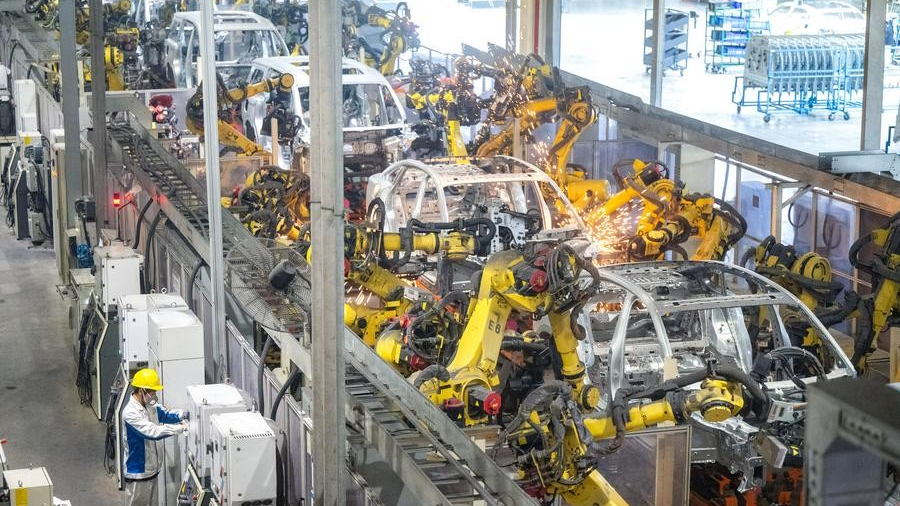[CGTN]夏璐:Modernization with Chinese style: Never change the nature of socialism
发布时间:2022-09-04Editor's note: Gao Lei is an associate professor and research fellow at the Collaboration Center for Theories and Practice of Open Economy, the Center for Xi Jinping Thought on Opening-up, the Research Institute of Globalization and China's Modernization, University of International Business and Economics. Xia Lu is an associate professor at the School of Marxism Studies and research fellow at the National Academy of Development and Strategies, Renmin University of China. The article reflects the author's opinions and not necessarily the views of CGTN.
Chinese President Xi Jinping paid an inspection tour to Liaoning Province on August 16-17, making it his third trip to northeast China since the 18th National Congress of the Communist Party of China and highlighting the value of this region.
Almost at the same time, Chinese Premier Li Keqiang held a symposium with provinces with key contributions to national economic growth in Shenzhen and paid a special visit to late Chinese leader Deng Xiaoping's Statue at the special economic zone, highlighting that China's reform and opening-up strategy shall continue to be the fundamental driving force of development.
These activities by the Party's central leadership, especially President Xi's inspection tour to northeast China, delivered clear and significant message to the outside world that China shall hold firmly to the nature of socialism with Chinese characteristics while making every effort to boost the national economy. In detail, some major points could be further grasped in the message.
First, people-centered philosophy got emphasized again. The people-centered philosophy has attained more meanings in reality in President Xi's inspection tour to northeast China. The victory of the Liaoshen Campaign during the War of Liberation more than 70 years ago could not be easily achieved if there was not the full support of the people in the northeast China.
According to the research by party and military historians, the Chinese people have made a great deal of sacrifice in ensuring the victory. Some scholars even argue that the victory of the War of Liberation in particular and the victory of Chinese revolution in general are by Chinese people and of Chinese people, therefore the fruit of the victory and the following construction of China's socialist modernization must be for Chinese people. That's why President Xi made it clear that common prosperity would be the priority and main feature of modernization with a Chinese style.
Second, balancing development among different regions, especially between north and south, got underlined as another important aspect of common prosperity.
As it was expounded by Deng Xiaoping in his southern inspection tour three decades ago, the concept of common prosperity encompassed a wide range of meanings, not only the equality and equity among social groups but also the balancing development among different regions.
Since the reform and opening-up, Chinese economy has developed rapidly as a result of the policy which allows certain segments of the population and certain regions to get well-off first. Yet it was a temporary measure rather than a long-term strategy, as the policy soon resulted in development imbalance.
At the early stage, the gap was significant between eastern regions, central regions, and western regions, especially during the period from 2003 to 2007, in terms of local Gross Domestical Product (GDP) in total and per capita.
In order to tackle this issue, the central government rolled out and implemented the famous Western Development Strategy, pushing local social and economic development to a much higher level as a shot in the arm. But China is such a vast country that the narrowing of the east-west gap doesn't necessarily mean the ending of development imbalance.
Economists have been closely watching the situation and they've found that 2019 is the watershed, with northern regions' GDP per capita compared to national average level declined from 92 percent in 2018 to 85 percent in 2019 while the southern regions' same data rising to 111 percent in 2019. As per the local GDP's contribution to the national in total, the northern regions declined from 43 percent in 2009 to 35 percent in 2019 while the southern regions went up from 57 percent in 2009 to 65 percent in 2019. What's more, the COVID-19 pandemic since 2019 has made things even worse.
That's why in the 14th Five-Year-Plan and 2035 Long-Range Objectives in late 2020, the central leadership has underlined regional coordination development as the key part to the high-quality development and common prosperity.
Last but not the least, the key role of self-reliance and independent innovation in science and technology has been underscored. As argued by researchers at Chinese Academy of Science and Technology for Development, a think-tank affiliated to the Ministry of Science and Technology, self-reliance and independence are the foundations to national development, security, and prosperity.
With the rising trend of protectionism, unilateralism, and "repressive-style" techno-nationalism, China is facing unexpected uncertainty and instability, especially in the field of science and technology. State-owned Enterprises (SOEs) should play a key role in this process in the new era.
As a region with a high concentration of SOEs of different levels, especially in key heavy industry fields and equipment manufacturing, the northeast has been equipped with certain first-mover advantages. Yet it's in urgent need of deepening reform in administration and communication.
In 1960s, when Sino-Soviet disagreement finally escalated into tensions between the two socialist countries, the aid from Soviet Union suddenly encountered severance. Then it was self-reliance and independent innovation that dragged China and Chinese scientists and technicians out of the morass of despair.
Six decades later, under the current domestic and international situations which are no worse than before, self-reliance and independent innovation must bring momentous effect.
原文链接:https://news.cgtn.com/news/2022-08-19/Modernization-with-Chinese-style-Never-change-the-nature-of-socialism-1cD3dMxTMha/index.html







